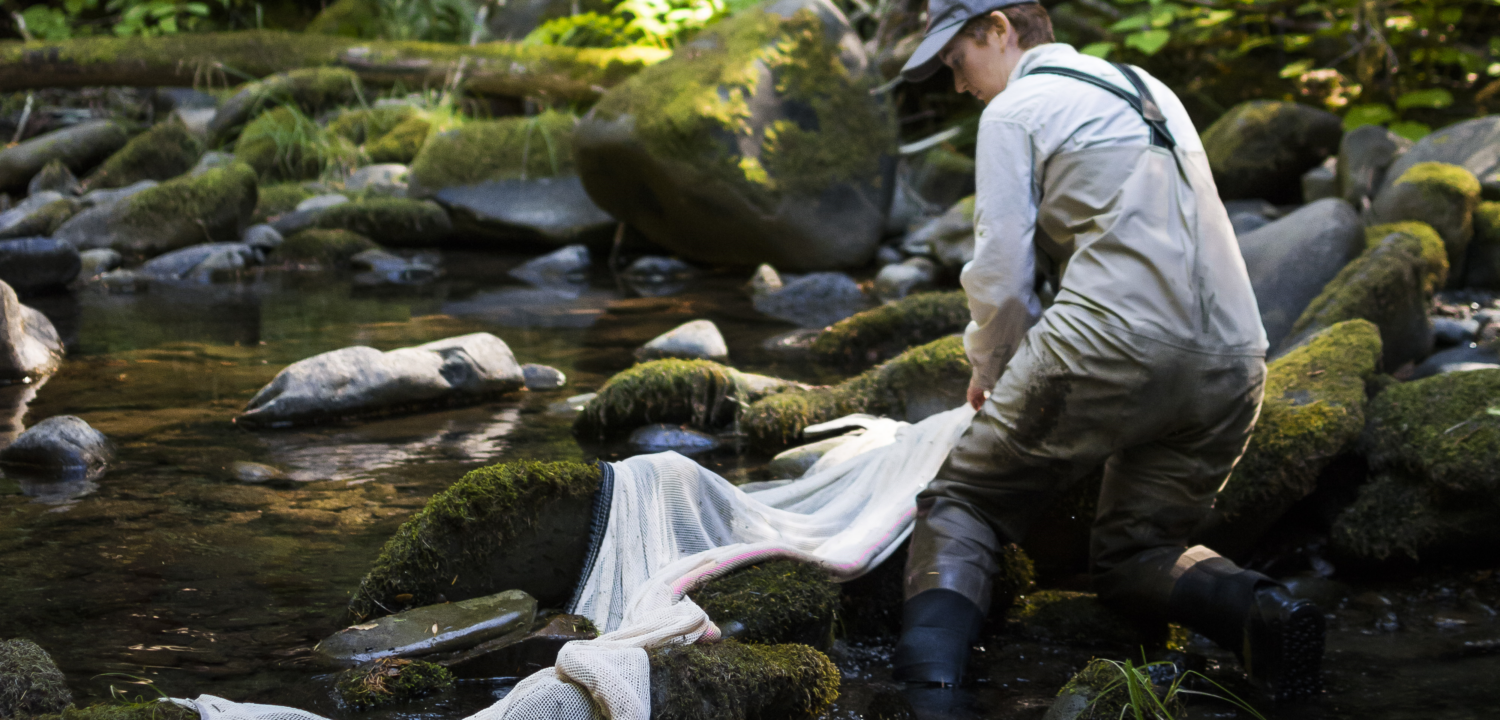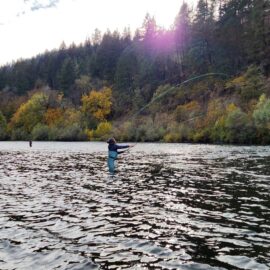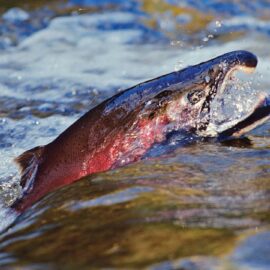Wild Salmon Center’s Science Advisory Board member has a fresh(water) take on salmon survival strategies.
To explain how we can help salmon survive today, Dr. Stephanie Carlson would like to draw your attention to the past. Specifically, the last ice age, when sheets of ice covered much of North America—in the process, sharply constricting the continent’s available habitat for Pacific salmon.
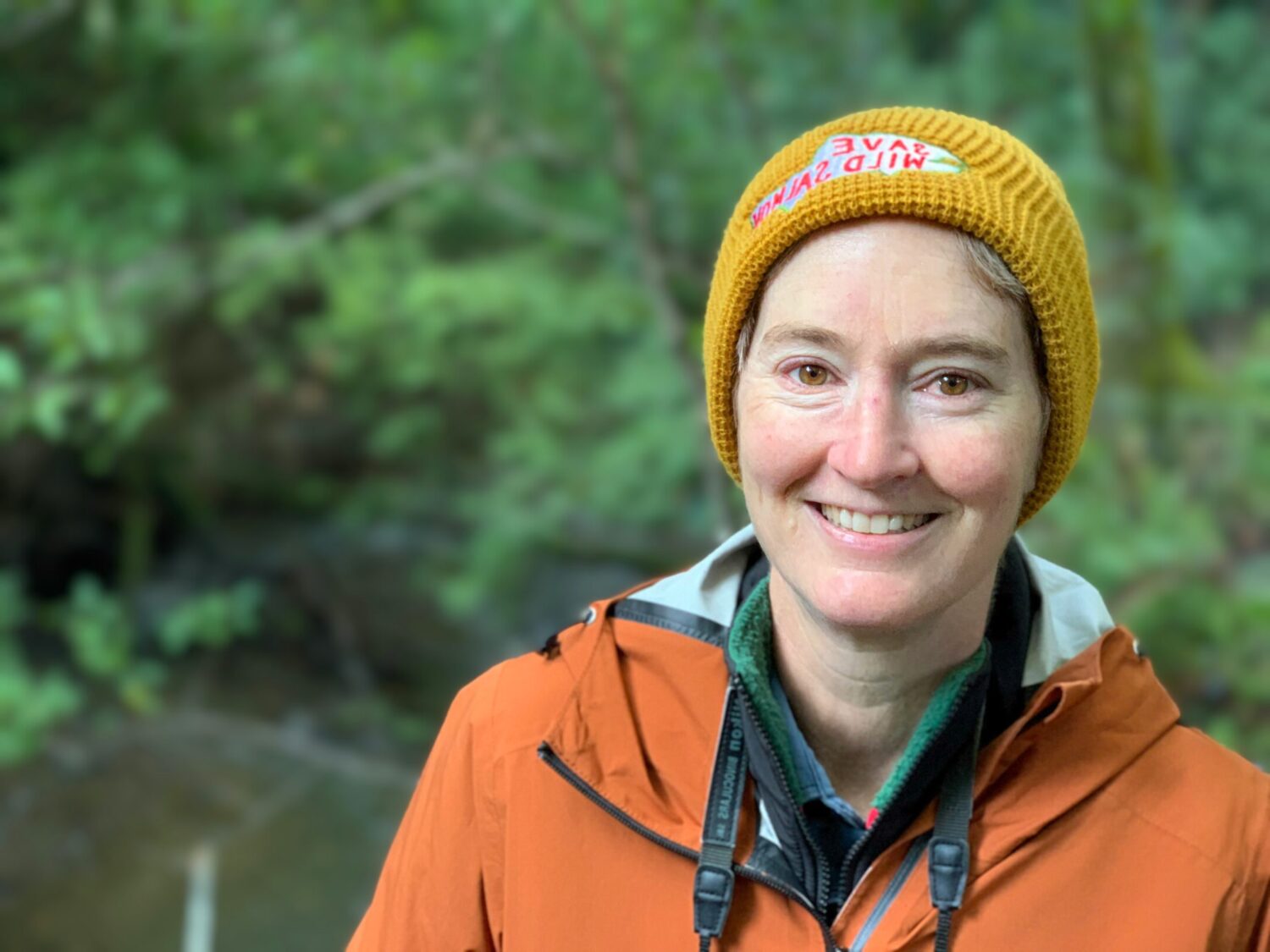
“A lot of the region that we consider salmon territory today was under a mile of ice,” says Dr. Carlson, a Wild Salmon Center Science Advisory Board member and freshwater ecologist at the University of California-Berkeley. “So these species contracted to just a few refuges.”
This constriction partly explains why the number of overall species on the West Coast is relatively low. But look closer, Dr. Carlson says, and you’ll find that many of these species—and salmonids in particular—contain multitudes.
“Our recent history of glaciation and the dynamic environment of the Pacific Rim meant that salmon and steelhead could find niches unoccupied by other species,” she explains. “This likely allowed for the incredible diversity and divergence we see within these species.”
This diversity shows up in the highly variable behavior that salmon can display, particularly in the southern end of their range, in places like California’s Central Valley, where Dr. Carlson was born and raised—and where salmon thrived, even during the last ice age.
Today, genetic and behavioral insights from conservation scientists including Dr. Carlson, WSC Polsky Conservation Fellow Dr. Tasha Thompson, and others are starting to upend the way we understand—and manage—many of these populations.
“The existence of different forms of these species is reflected in Indigenous knowledges, languages, and cultures,” Dr. Carlson says. “But in the context of Western fisheries management, this recognition is more recent, and still taking root.”
Below, Dr. Carlson shares some of what she and others are now learning about the wide world of salmonid life histories: the diverse paths they take throughout their lives, from freshwater to ocean and back. For these species, she says, such wild intraspecies diversity is a key feature, not a bug. It’s how salmon and steelhead have outlasted floods and ice ages. And it could be key to helping these species survive the cataclysms of today.
A Conversation With Dr. Stephanie Carlson
Wild Salmon Center: We’re living at a time of exciting new discoveries about salmon and steelhead. What are you learning that might surprise us?
Dr. Stephanie Carlson: I can give an example about coho salmon. People often consider coho to have a pretty simple life history, especially at the southern end of their range. In California, they expect a sort of strict, three-year life history: a year in freshwater, then they migrate to the ocean, where they stay for 18 months, and then back into freshwater to spawn and die.
Yet people have recognized for decades that when they run a net through estuaries along the West Coast, they often capture these tiny coho fry. These are fish that emerged from the gravel maybe only a few months earlier, yet seemed to have moved directly down to the estuary.
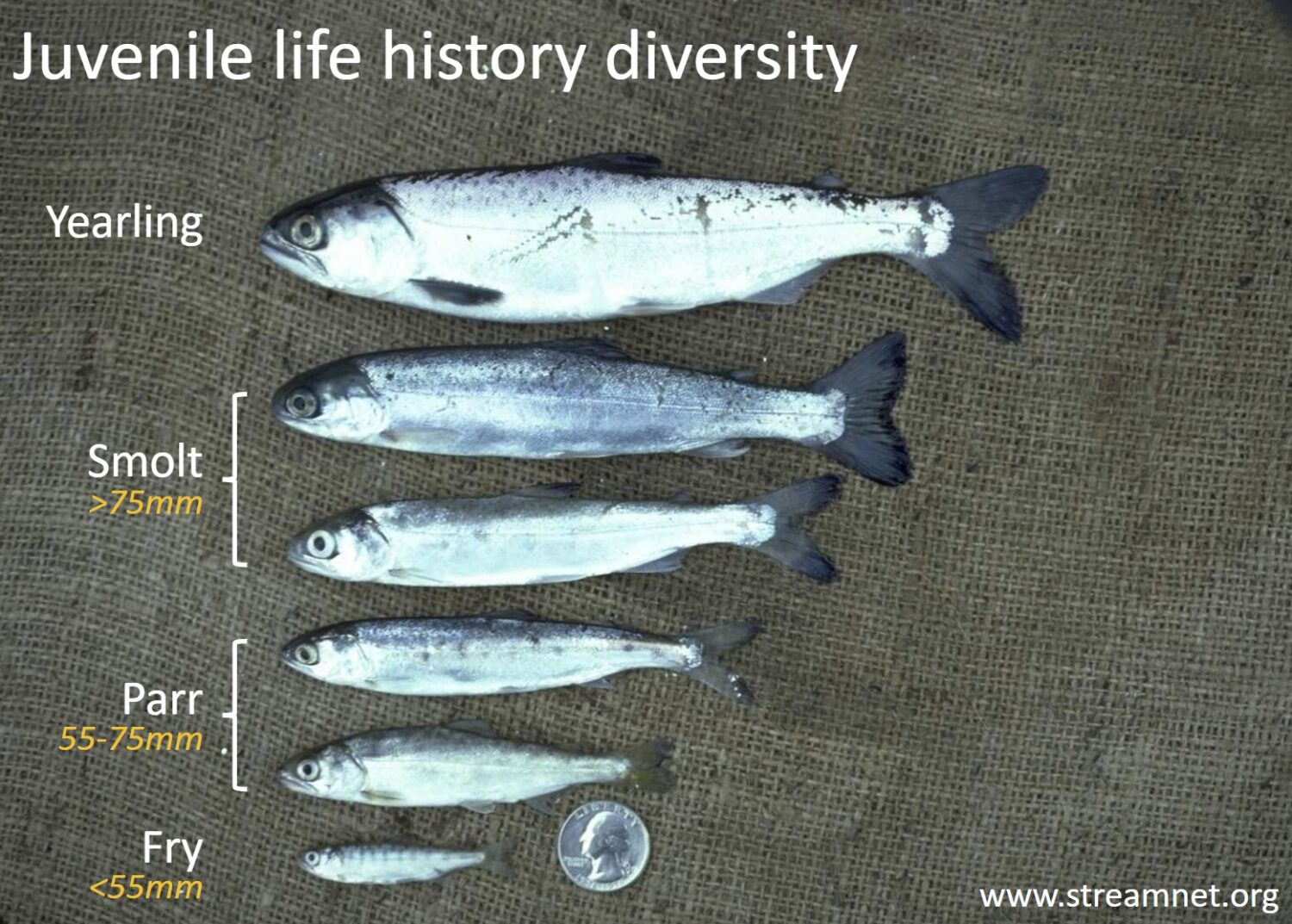
WSC: So these fry didn’t stay and rear in pools and pockets relatively close to where they first emerge from the gravel. That’s not what we think of as the common life history for coho salmon, right?
Dr. Carlson: Right. Some assumed that these were the fish that didn’t establish territories upstream—and also that these fry were going to just perish in the ocean. But recent work using otolith microstructural and microchemical analyses [Editor’s note: otoliths are essentially “ear stones” that, when analyzed, can help reconstruct early salmonid habitat use and life history patterns] has instead revealed that in some years, and in some places, those fry that migrated early in life to the estuary can make up 30 to 50 percent of the returning adults!
WSC: Okay, so if these fry were not necessarily forced out, why might they have chosen to leave home? It sounds like a huge risk for a fish smaller than most people’s little finger…
Dr. Carlson: There’s a few different hypotheses about why these fry out-migrated, as we say, so early in life. One is simply that these are fry who got displaced in large flood events—but that if they manage to find suitable habitat downstream, can recover and in fact do quite well and survive to adulthood. Another is competition-based: that if you have a really high density of spawners in a particular year and fry emerge in an environment where the territory is already occupied, some leave early to find suitable habitat elsewhere.
WSC: So we’re learning that even at the earliest stages of life, salmon and steelhead might be writing their own scripts. For you, what’s the takeaway of this insight?
Dr. Carlson: It emphasizes to me the importance of increasing our focus on downstream habitats. We already understand the importance of stopover sites for other species: for birds and migratory ungulates. So I think that there’s an opportunity to lean into this, and recognize that there are key habitats, like floodplains and estuaries, where fish will slow down, feed, grow, and reach larger sizes. These stopovers can change the timing of their outmigration in ways that could matter for their population dynamics.
We already understand the importance of stopover sites for other species: for birds and migratory ungulates. There’s an opportunity to recognize that there are key habitats, like floodplains and estuaries, where fish will slow down, feed, grow, and reach larger sizes.
Dr. Stephanie Carlson, UC-Berkeley
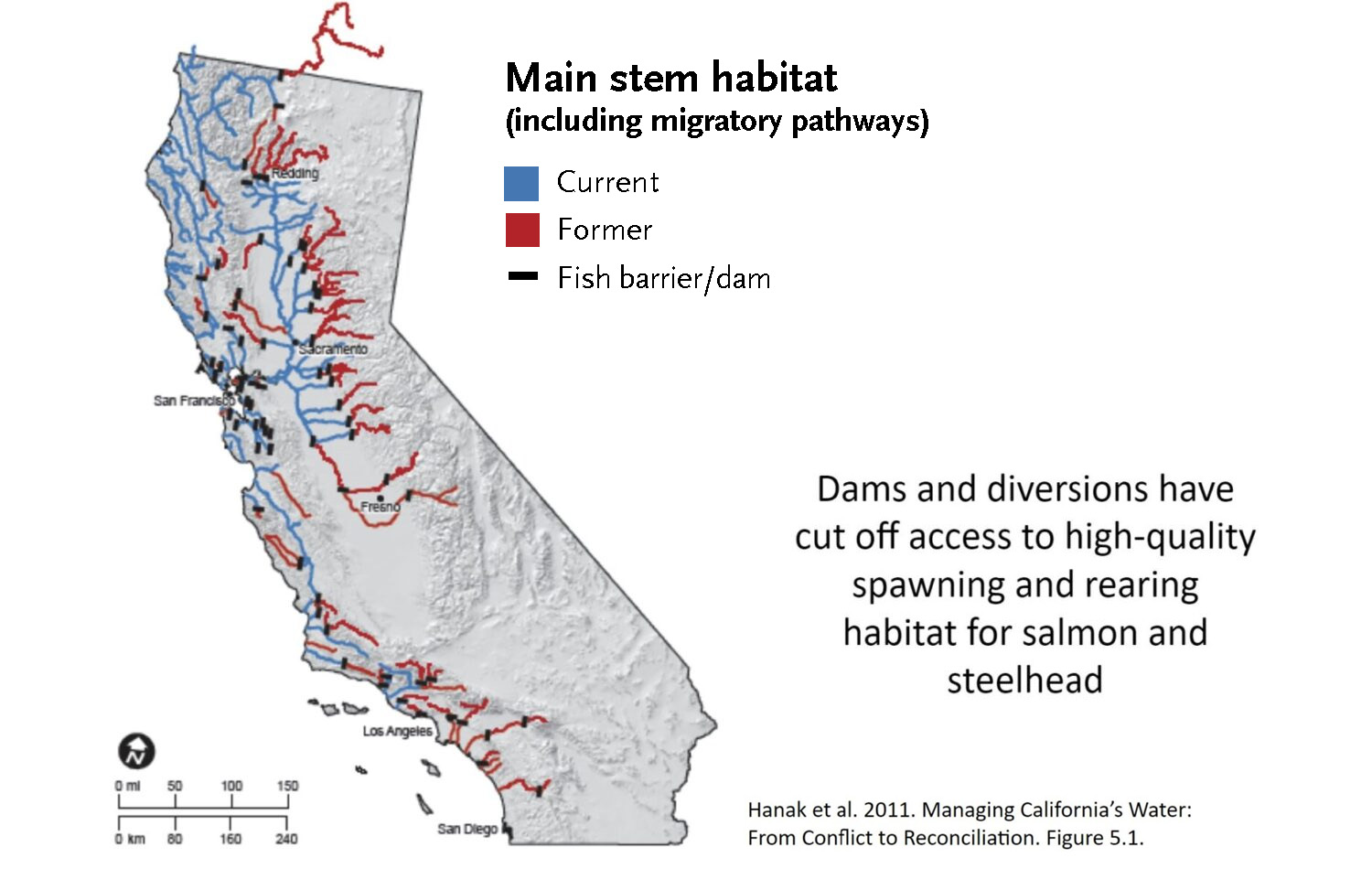
WSC: So if we want more juvenile salmon to have a shot at making it to the ocean, we should be thinking about protecting habitat beyond spawning grounds?
Dr. Carlson. Potentially, yes. These days, we think a lot about where the best restoration opportunities are. Often, we focus on increasing miles and acres of connected habitat—and that’s important. But different restoration activities can also support and even unlock different life histories. We could also look at overall diversity of habitat: river mainstems, floodplains, wetlands, estuaries, and the life history paths supported by those different habitats. It sort of changes how we might think about spending restoration dollars.
WSC: Any other surprising findings from recent work in California?
Dr. Carlson: I can give another example of a life history that’s important for salmon resilience. In California, at the southern end of the range for Chinook salmon, recent work revealed that the late-migrating salmon that spend a year in freshwater before migrating to the ocean were those most likely to survive recent drought conditions.
During extreme drought conditions, these late migrators made up nearly 100 percent of the returning adults! This late migrating life history is most common in higher-elevation, snow-melt sites—habitat that today is mostly upstream of large impassable dams. This emphasizes the need to reconnect habitats to restore the late-migrating form, and give the species a chance at survival in a warmer world.
WSC: So some young salmon find success by leaving home early, while others find it by lingering longer in freshwater. That is indeed what we call the portfolio effect of salmon survival strategies! Dr. Carlson, thank you so much for sharing these insights. Any parting thoughts for us?
Dr. Carlson: For me, a key takeaway from this work is that when populations encounter a mosaic of habitats, there’s the potential for the expression of diverse life histories—and that portfolio of strategies gives these species options in a warming and increasingly variable world.
When populations encounter a mosaic of habitats, there’s the potential for the expression of diverse life histories—and that portfolio gives these species options in a warming and increasingly variable world.
Dr. Stephanie Carlson, UC-Berkeley
